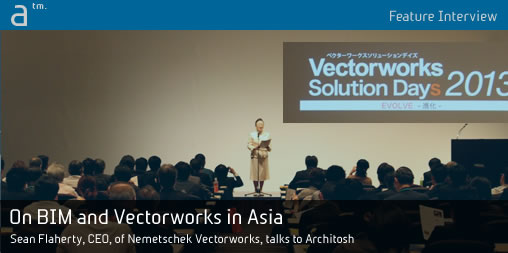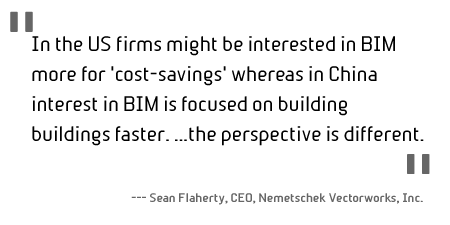Continued from page 1
Big Asia and Big BIM: What exactly is the size benefit?
Many articles on BIM have been written that pitch the benefits of BIM across nearly an even spectrum of possibilities, from streamlined documentation creation for all architects on all scale size of projects to engaging collaborative workflows across discipline and in depth analysis that was not possible with 2D. But as we learned from our Architosh 2010 BIM Survey Report, while architects are often prone to thinking that BIM benefits run across the gamut of project type and scale uniformly, there are actually significant differences across both of those spectrums. Here Flaherty explains it a bit differently…
Advertisement
AFR: So are you saying the bigger the project the bigger the payoff for BIM. How do you characterize this payoff from the dashboard view of your many customers?
SF: I guess I would say there is some exponential benefit gained with the analysis side of BIM workflows based on size. The larger the building the more it tends to be more complicated and with BIM that’s where the analysis pays off as you begin to share building models with your extended team and consultants.
Whereas, you can take small scale residential and you still gain the design benefits of BIM but you don’t gain necessarily with all the areas of the analysis. You don’t do full-scale plumbing analysis for instance.
AFR: So how is payoff the same or different in Japan?
SF: The payoff is a little bit different on the construction side as well in Japan. Over there the emphasis on the relationship between the owners and the large construction companies tends to be one based on forming long-term relationships. That changes the relationship dynamics and what those two parties focus on with each other.
Say you have a company like Toyota and they have these long-term suppliers. The suppliers setup for these relationships in a manner that is beneficial to Toyota long term. So unlike America where you don’t quite have that and you focus on the lowest bidder the nature of BIM in Japan is a bit different due to these ‘long-term oriented’ partnerships and the differing dynamics.
AFR: That is very interesting.
On China: Signal vs Noise and the Architectural License
AFR: So can we talk about China? China is the next big large global market for just about everyone and everything. What are your China plans…what can you share today?
SF: Sure.
AFR: What is your background with Vectorworks in China?
SF: Well we’ve been distributing in China in Hong Kong in English language for quite sometime. But obviously China is a local language market. So that is not the match market approach. We launched last April our first local Chinese language edition. And now our real access to customers has changed dramatically.
AFR: So are you making good headway in China?
SF: So entering China is a lot like entering the US as a market. It is so big, there are so many people, and everyone is talking about the future, there is just a lot of noise right now. It is hard for us to get in there and make noise as well.
AFR: So is the market much different than Japan?
SF: China is actually very different. They have these really big architecture studios. Now there are big architectural practices everywhere in the world but the difference is this. Architects are not individually licensed in China. Firms are licensed. And that is through the government and over there a lot of things are government owned.
AFR: I see. So it’s almost the inverse as in the United States and elsewhere. How do you individually practice?
SF: You need to run your projects through a licensed studio–these big studio companies. From our view that is the only market in the world that works that way.
AFR: I didn’t realize China worked that way. That would seem to discourage sole-proprietorship?
SF: Yes, well, you can still work independently but you would need to get a large studio to authorize your work. To free market America that might sound foreign. But when you do international work you have to learn and get used to the differences. We are still learning and adapting to China.
On China: BIM and Speed…It’s the Wild West Again
AFR: So that would suggest with China’s architectural market being nearly inverted to elsewhere in the world where small scale practice thrives that BIM requirements might be different. Is that the case?
SF: Yes and no. Chinese firms are not really asking for anything quite so different than say what an American architecture firm is asking for. But the difference is this. In the US firms might be interested in BIM more for “cost-savings” whereas in China interest in BIM is focused on building buildings faster. They are looking at BIM as a “time-savings” tool not a “cost-savings” tool. Of couse time is money so they are clearly related but the perspective is different.
AFR: Right. So China is just growing so quickly that there is this “simply can’t build fast enough mentality”?
SF: Yes, I think that is part of it. China is in this giant economic shift, kind of like America in the late 19th century. Except this time people are migrating towards the developing cities, not away from cities and into the frontiers.
Architosh Commentary
As we mentioned earlier, like the Don Jacob interview series, this series with Sean Flaherty consists of several parts. In this first part we get an interesting glimpse of BIM in Asia seen from the Vectorworks perspective. What many in the US in particular may not know is that in Japan Nemetschek Vectorworks has many of its largest customers, with some far exceeding 1000 seats of Vectorworks. These are jumbo sized companies by any country’s standard.
Flaherty’s remarks reinforce the Open BIM movement’s voice about plurality of solutions and the need for standards-based interoperability. In Japan what we hear is that businesses setup with others in a long-term focused way, and this in turn affects the procurement of supplies and those relationships in turn are affected. How can that not have an impact on say, BIM data file formats for building components within Japan’s construction industry? Clearly it would and this is another excellent example of how a “one size fits-all” approach to BIM doesn’t work in giving all users ‘best of breed’ solutions.
We find it very enjoyable to hear the subtle differences of “perspective” in China towards BIM. We all know that time and money are on opposite sides of the equal sign in the larger design-build equation, but where a country’s perspective lays its emphasis is quite interesting. Yet, we learn that architecture firms in China are looking for essentially the same things as US-based firms.
Lastly, Nemetschek Vectorworks’ native language versions for China are relatively young. It will be interesting to see how Vectorworks takes hold in China. Will the company be able to penetrate these larger licensed studios? Could Vectorworks’ success in large firms in Japan be a model for China? These are some of the questions we will have to wait a few years for answers to.






Reader Comments
Kazutaka Satoh liked this on Facebook.
Kazutaka Satoh liked this on Facebook.
Architosh talked to our CEO, Sean Flaherty, about BIM and Vectorworks in Japan and China. Read it here:… http://t.co/Rsry2f6znd
Architosh talked to our CEO, Sean Flaherty, about BIM and Vectorworks in Japan and China. Read it here:… http://t.co/Rsry2f6znd
RT @Vectorworks: Architosh talked to our CEO, Sean Flaherty, about BIM and Vectorworks in Japan and China. Read it here:… http://t.co/Rsr…
RT @Vectorworks: Architosh talked to our CEO, Sean Flaherty, about BIM and Vectorworks in Japan and China. Read it here:… http://t.co/Rsr…
RT @Vectorworks: Architosh talked to our CEO, Sean Flaherty, about BIM and Vectorworks in Japan and China. Read it here:… http://t.co/Rsr…
RT @Vectorworks: Architosh talked to our CEO, Sean Flaherty, about BIM and Vectorworks in Japan and China. Read it here:… http://t.co/Rsr…
Comments are closed.